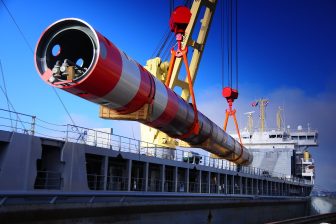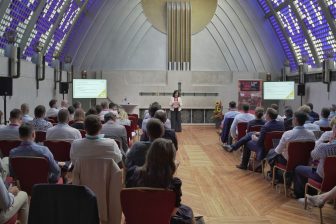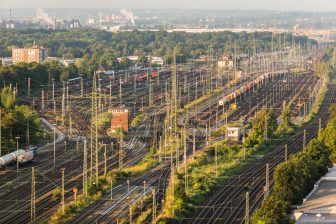
PCS 2022: MPP fleet in urgent need of renewal
With European appetite for alternative energy sources growing as well as its offshore wind targets reaching new heights, it is becoming more and more obvious that the MPP fleet serving the project logistics sector will not be sufficient. There is also an urgent need for a political framework that would create the necessary tools for the renewables industry supply chain to function without many hick-ups, and for the European shipyards to be more competitive in the MPP shipbuilding landscape.
Goals set by governments may have disregarded the capacity of the supply chain to serve the proposed projects. Looking at the MPP fleet, there is an obvious risk that it will not be able to adequately respond to the upcoming demand. Speaking during the Project Cargo Summit, Yorck Niclas Prehm, head of research at Toepfer Transport, noted that there are certain issues with the fleet. “The order book shrank a lot, the fleet is getting older and older, and the number of vessels available to the market will further decrease over the next five to ten years,” he said.
The MPP order book currently represents only 2.3 percent of the sailing fleet. Additionally, with over 25 percent of the MPP fleet being 16 years or older, over the next five to ten years, a similar percentage will leave the market with only three to five percent of newbuilds coming into the market.
The second-hand market does not offer much relief as it also remains quite tight. In addition these are not the vessels that provide the needed efficiency.
Responding to a question about what is being done to make sure more tonnage enters the market soon, and what the next steps could be, Prehm said, “Not much, that is the way it is. You see companies going for deck careers and other tonnage, and everyone is looking for alternatives. The key solution for all the problems and the whole supply chain is, we need vessel space, and we need modern and economic vessel space.”
But, the order book is an activity indicator. There is not much activity in terms of newbuilds, despite some companies trying to stay active, the economic landscape is changing. Interest rates are rising, equipment prices are increasing as well as the workforce and materials costs, and the shipyards are working on low profit margins, but with the current market correction, there is more uncertainty in a very difficult market.
Geopolitical uncertainty persisting
In a similar way it is difficult to forecast how far the charter rates for the MPP fleet will be pegged back, it is also difficult to forecast how long this type of market environment will continue.
This all makes it complicated for owners and operators to place their orders. While their earnings have been significant over the past couple of years, the calculations have to make sense for a decision to be made.
“The question now becomes when is the right time to make a commercial decision. With interest rates going up, it is maybe too late,” Prehm says. And the MPP sector may be facing more obstacles that could stem from the geopolitical shift we are currently witnessing.
In one of its recent studies, Toepfer Transport noted that for one size segment of the MPP market, 50 percent of the fleet is controlled from one single large nation which also controls a huge portion of the newbuilding yards for the MPP sector. Prehm clarified that this country is China, and the segment mentioned in the study is vessels between 25,000 dwt and 40,000 dwt. These are the large vessels, which will be key in supporting the upcoming demand from the renewable energy sector. “And we need a lot of deck space, high capacity vessels to carry all the towers for offshore and onshore wind,” Prehm said.
He further added that 50 percent of the fleet is controlled by Chinese entities and the very few vessels remaining available in the charter market are controlled in China which could mean that the supply chain for European renewables strategy is dependent on a single country, much like it was highly dependent on Russian natural gas. “If there are any further changes in the geopolitical landscape, this might cause issues,” Prehm stresses.
He fears that Europe’s decision to cut its dependence on Russian fossil fuels have been highly political and have created further issues for the supply chain as there is simply not enough capacity to carry all the equipment needed for wind projects set to be built over the next few years.
“The goal is to build larger vessels, that is what wind manufacturers would like to have,” Prehm says, adding that there is also a need for a political framework that could assist in creating the right tools for the supply chain. The framework could also ensure that more newbuilds are actually built in Europe, which is not the case currently.
Factors stifling MPP fleet expansion
As Prehm noted during Project Cargo Summit, China has a firm grip on the construction of MPPs and its yards are capable of delivering large series of vessels. This, coupled with the fact that European yards are focusing on navy vessels and cruise ships, means that there are not many MPPs built in Europe.
“European shipyards are not able to build a series of vessels,” says Prehm. Currently, alternative places for construction of MPPs are Indonesia, India, Vietnam, South-East Asia, while European shipyards, except some of the Dutch yards, will have difficulties being competitive on the MPP construction market.
And it is not simply the case of finding a slot at a shipyard and placing an order for an MPP newbuild. Building these vessels is complicated considering many aspects of these vessels such as the installation of massive cranes. Experienced yards and highly skilled workforce is required to carry out this work.
Furthermore, there is the financial aspect of building these vessels. As Prehm already said, the calculations have to be right, and the charter rates, although slipping slightly, would need to remain at the currently high levels.
“With the high amount of demand which is coming up for the next few years we strongly believe that the rate levels will remain very high,” Prehm said. In the latest monthly report, Toepfer Transport’s Multipurpose Index slipped 6.1 percent month-on-month settling at $20,289 for the month of October 2022.
“They [rates] have to remain high. Because when it comes to the urgent need of fleet renewal in the market, there is a lot of replacement required, the fleet has to become greener, the environmental footprint becomes more and more important on the shippers side, and also on the carriers side. In order to start and develop newbuilding projects, the rates have to stay sustainable enough to support the current newbuilding prices,” says Prehm.
The complexity of building an MPP vessel is also a sort of a stumbling block for many yards as they are unwilling to build these vessels despite some owners and operators trying to invest in newbuilds. “It is much easier, technically easier, to build container ships, large series of 20 container ships, so when a European owner or operator comes up and says I want to build four MPPs, it is not that interesting,” Prehm said.
Furthermore, the technical complexity of MPPs means that owners are sending newbuilding supervision teams to the yards to oversee the construction and make sure shipyards adhere to the guidelines. This makes it difficult for owners and operators to secure yard space, as shipyards tend to give an advantage to companies ordering series of container vessels of the same design.
Looking further ahead in the future, and the goals to decarbonise shipping, owners are facing a difficult choice when it comes to deciding on the fuel option for their newbuilds. Prehm stresses that there is a question of bunkering infrastructure at ports that MPP vessels call, and the shipowners are facing the dilemma of which fuel option to go with.
“While container ships usually call main ports with a good fuel supply situation, MPP ships go to places which are close to the final destination of the cargo. Most of the alternative fuels (e.g. LNG, Methanol) are currently only available at main ports since it takes time and sufficient demand to build up the required infrastructure at smaller ports,” he said.
Also read: SAL Heavy Lift and Jumbo place joint order for Orca Class heavy lift vessels
European offshore wind targets have been set high and in order to make sure the supply chain continues to serve the proposed projects smoothly, there has to be a framework in place to help create the required tools. Prehm believes that there is no time to dwell on political decisions and their implementation if Europe’s renewables targets are to be reached on time.
You just read one of our premium articles free of charge
Register now to keep reading premium articles.




